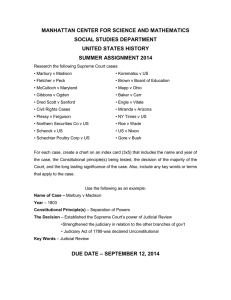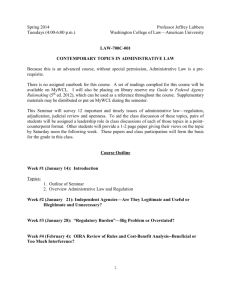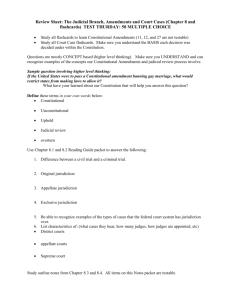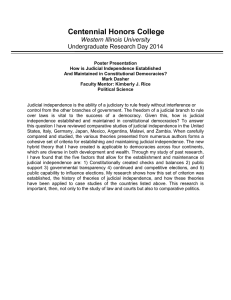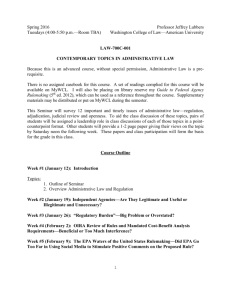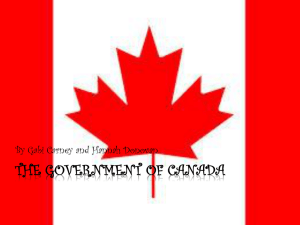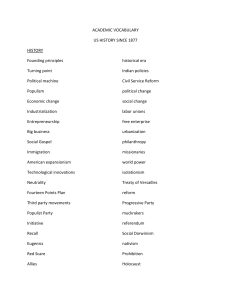Some Reflections on the Symposium: Judging, the Classical Legal Paradigm, and
advertisement
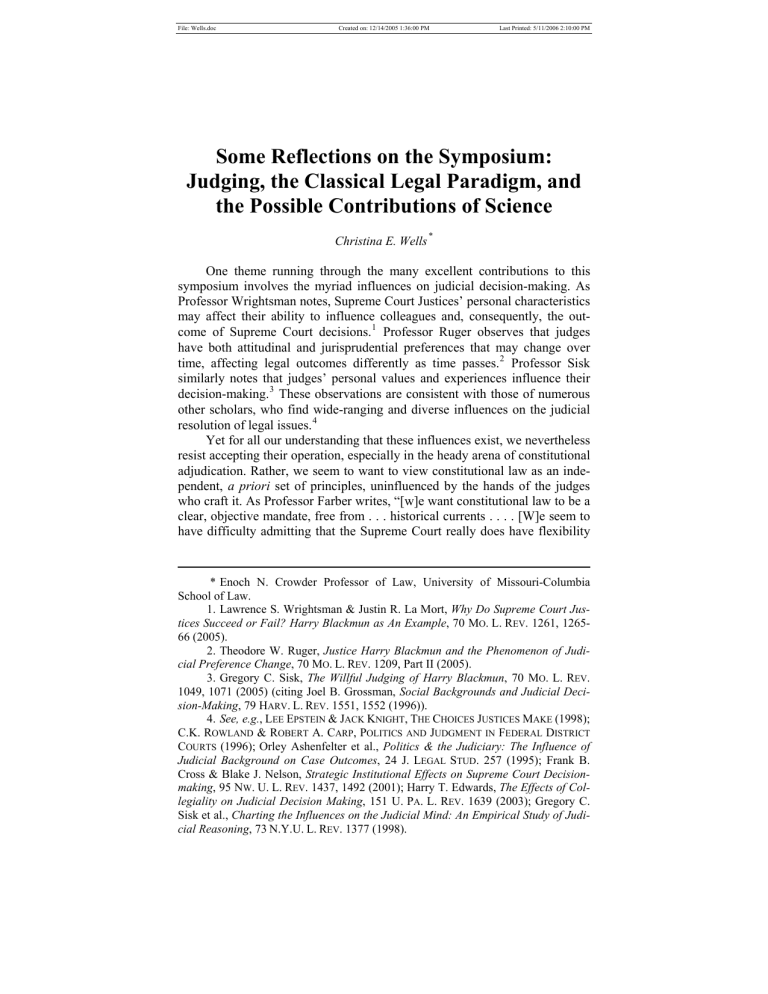
File: Wells.doc Created on: 12/14/2005 1:36:00 PM Last Printed: 5/11/2006 2:10:00 PM Some Reflections on the Symposium: Judging, the Classical Legal Paradigm, and the Possible Contributions of Science Christina E. Wells * One theme running through the many excellent contributions to this symposium involves the myriad influences on judicial decision-making. As Professor Wrightsman notes, Supreme Court Justices’ personal characteristics may affect their ability to influence colleagues and, consequently, the outcome of Supreme Court decisions. 1 Professor Ruger observes that judges have both attitudinal and jurisprudential preferences that may change over time, affecting legal outcomes differently as time passes. 2 Professor Sisk similarly notes that judges’ personal values and experiences influence their decision-making. 3 These observations are consistent with those of numerous other scholars, who find wide-ranging and diverse influences on the judicial resolution of legal issues. 4 Yet for all our understanding that these influences exist, we nevertheless resist accepting their operation, especially in the heady arena of constitutional adjudication. Rather, we seem to want to view constitutional law as an independent, a priori set of principles, uninfluenced by the hands of the judges who craft it. As Professor Farber writes, “[w]e want constitutional law to be a clear, objective mandate, free from . . . historical currents . . . . [W]e seem to have difficulty admitting that the Supreme Court really does have flexibility * Enoch N. Crowder Professor of Law, University of Missouri-Columbia School of Law. 1. Lawrence S. Wrightsman & Justin R. La Mort, Why Do Supreme Court Justices Succeed or Fail? Harry Blackmun as An Example, 70 MO. L. REV. 1261, 126566 (2005). 2. Theodore W. Ruger, Justice Harry Blackmun and the Phenomenon of Judicial Preference Change, 70 MO. L. REV. 1209, Part II (2005). 3. Gregory C. Sisk, The Willful Judging of Harry Blackmun, 70 MO. L. REV. 1049, 1071 (2005) (citing Joel B. Grossman, Social Backgrounds and Judicial Decision-Making, 79 HARV. L. REV. 1551, 1552 (1996)). 4. See, e.g., LEE EPSTEIN & JACK KNIGHT, THE CHOICES JUSTICES MAKE (1998); C.K. ROWLAND & ROBERT A. CARP, POLITICS AND JUDGMENT IN FEDERAL DISTRICT COURTS (1996); Orley Ashenfelter et al., Politics & the Judiciary: The Influence of Judicial Background on Case Outcomes, 24 J. LEGAL STUD. 257 (1995); Frank B. Cross & Blake J. Nelson, Strategic Institutional Effects on Supreme Court Decisionmaking, 95 NW. U. L. REV. 1437, 1492 (2001); Harry T. Edwards, The Effects of Collegiality on Judicial Decision Making, 151 U. PA. L. REV. 1639 (2003); Gregory C. Sisk et al., Charting the Influences on the Judicial Mind: An Empirical Study of Judicial Reasoning, 73 N.Y.U. L. REV. 1377 (1998). File: Wells.doc 1310 Created on: 12/14/2005 1:36:00 PM MISSOURI LAW REVIEW Last Printed: 5/11/2006 2:10:00 PM [Vol. 70 in construing the Constitution.” 5 Thus, when Justice Blackmun authored Roe v. Wade, grounding the abortion right in a trimester framework untethered to constitutional text or history, 6 many observers did not simply cast the decision as wrong; they implied that it was illegitimate. As Professor John Hart Ely claimed, Roe was not just “bad constitutional law,” it was “not constitutional law.” 7 To its critics, then, Roe was an exercise of raw power by an imperial judge bent upon imposing his will upon the American populace. 8 While criticism of Roe stems partly from its unique nature, it also indicates a more general uneasiness with judicial review and the “problem of judicial flexibility.” 9 Tracing back at least to Alexander Bickel’s pronouncement of judicial review as “countermajoritarian,” 10 scholars have obsessed over the legitimacy of judicial review of constitutional issues. 11 As a result, they seek “formula[s to] resolve constitutional cases” that are intended to constrain judicial discretion, 12 be they “neutral principles” 13 or “originalist” interpretations of the Constitution. 14 As Professor Farber quite rightly points out, however, no formula can eliminate the need for judgment and flexibility in constitutional adjudication. 15 Nevertheless, constitutional scholars continue their quest for a principle of constitutional interpretation that will both constrain and legitimate judicial review all at once. 16 5. Daniel A. Farber, Did Roe v. Wade Pass the Arbitrary and Capricious Test?, 70 MO. L. REV. 1231, 1234 (2005). 6. Roe v. Wade, 410 U.S. 113, 164-65 (1973) (plurality opinion). 7. John Hart Ely, The Wages of Crying Wolf: A Comment on Roe v. Wade, 82 YALE L.J. 920, 947 (1973) (emphasis in original). 8. MICHAEL J. PERRY, MORALITY, POLITICS, AND LAW 175 (1988); Sisk, supra note 3, at 1054 (citations omitted). 9. Farber, supra note 5. 10. ALEXANDER BICKEL, THE LEAST DANGEROUS BRANCH (1962). 11. Barry Friedman, The Birth of an Academic Obsession: The History of the Countermajoritarian Difficulty, Part Five, 112 YALE L.J. 153, 253-54 (2002). 12. Farber, supra note 5. 13. Herbert Wechsler, Toward Neutral Principles of Constitutional Law, 73 HARV. L. REV. 1 (1959). 14. ROBERT BORK, THE TEMPTING OF AMERICA: THE POLITICAL SEDUCTION OF THE LAW 257 (1990). 15. Farber, supra note 5. 16. Scholars fall primarily into two camps. First, there are those who find judicial review an anathema but grudgingly accept its presence in our constitutional order as inevitable. See, e.g., BORK, supra note 14. They, thus use constraining principles such as originalism as a way to restrict judicial review. See, e.g., id. In their view, such restricted judicial review is legitimate. See, e.g., id. The second camp involves liberal defenders of judicial review who attempt to respond to the countermajoritarian difficulty by using constraining principles as a way to legitimate judicial review and, especially, to legitimate its use to expand constitutional rights. See, e.g., Wechsler, supra note 13; see also Friedman, supra note 11 (discussing history of liberal defense of judicial review). File: Wells.doc 2005] Created on: 12/14/2005 1:36:00 PM CONTRIBUTIONS OF SCIENCE Last Printed: 5/11/2006 2:10:00 PM 1311 Why this obsession with constraining judicial review? The answer lies, at least in part, with the normative image of judges that seems to lie at the heart of these debates – an image that traces back over a hundred years to the classical legal paradigm. In this paradigm, associated most prominently with Christopher Columbus Langdell, law consisted of a few fundamental, a priori principles from which legal rules could be deduced. 17 In this sense, law was scientific and judges were scientists. 18 In their role as scientists, judges essentially discovered law; they did not make it. Indeed, the classical legal paradigm “left no room for any judicial individuality, much less any expression of judicial ideology.” 19 The legal realism movement of the early 20th century, with its pragmatic focus on the “connections between law and actual life experience,” essentially debunked the formalistic, classical legal paradigm. 20 Nevertheless, the notion of judge as discoverer “is very much alive and doing remarkably well in American law.” 21 In fact, although outside the scope of this brief comment, if one were to dig more deeply, the metaphor of judge as scientist is at the heart of attempts to constrain, and thus legitimate, constitutional adjudication. The difficulty in constitutional adjudication, of course, is that there is little constitutional law to “discover” in the way of a priori principles. Thus, there is a particularly acute tension between the way that judges actually act in constitutional adjudication and the hypothetical ideal of how judges should act. Indeed, one could credit this tension as the source of the current scholarly obsession with constraining constitutional review. 22 Ironically, the classic legal paradigm at the heart of this debate itself misconceives the practice of science upon which it is built, which may contribute to this obsession. The classical legal paradigm equates science with neutrality and its methods with objective, value-free discovery of naturally 17. See Thomas C. Grey, Langdell’s Orthodoxy, 45 U. PITT. L. REV. 1 (1983). Although we associate this view primarily with Langdell, who pioneered the modern study of law, id. at 1-2, the concept of law as a scientific body of discoverable principles preceded Langdell both in the United States and Europe. M.H. Hoeflich, Law & Geometry: Legal Science From Leibniz to Langdell, 30 AM. J. LEGAL HIST. 95, 95 (1986); Howard Schweber, The Science of Legal Science: The Model of the Natural Sciences in Nineteenth-Century American Legal Education, 17 LAW & HIST. REV 421 (1999). 18. Frank B. Cross, Political Science and the New Legal Realism: A Case of Unfortunate Interdisciplinary Ignorance, 92 NW. U. L. REV. 251, 255 (1997); Grey, supra note 17, at 5-6, 13. 19. Cross, supra note 18, at 255. 20. Joseph William Singer, Legal Realism Now, 76 CAL. L. REV. 465, 469 (1988) (reviewing LAURA KALMAN, LEGAL REALISM AT YALE: 1927-1960 (1986)); see Cross, supra note 18, at 256. 21. Dan Simon, A Psychological Model of Judicial Decision Making, 30 RUTGERS L.J. 1, 10 (1998). 22. For a similar argument in a slightly different context, see Friedman, supra note 11. File: Wells.doc 1312 Created on: 12/14/2005 1:36:00 PM MISSOURI LAW REVIEW Last Printed: 5/11/2006 2:10:00 PM [Vol. 70 existing phenomenon. Yet science as scientists practice it bears little resemblance to this concept. “[S]cience is a complex and messy business” in which scientists often muddle through as best they can. 23 As Karl Popper noted decades ago, “[s]cience is not a system of certain, or well-established, statements; nor is it a system which steadily advances towards a state of finality. Our science is not knowledge: it can never claim to have attained truth, or even a substitute for it, such as probability.” 24 Furthermore, scientists are not free from subjective and value-laden influences. Scientific investigation does not involve robotic processing of data; rather it is theory driven. 25 And to choose a theory is to inject values into science. 26 Similarly, science is a social endeavor. Scientists communicate with one another. Accordingly, the results of science are as much the result of discourse regarding scientific results as they are the “discovery” of an objective reality. 27 Finally, scientific results often require interpretation, which is “neither a simple nor a disinterested process.” 28 Yet for all these subjective influences we nevertheless believe in the products of science – i.e., that they are trustworthy, objective, reliable, and rigorously tested rather than manifestations of subjective whim. How is it that we have come to trust the products of scientific endeavor despite these complex and subjective influences? Much of that trustworthiness comes from the fact that science is a public system of knowledge. To maintain credibility, scientific results must be openly shared and subjected to critique. Thus, scientific results are not trustworthy because they are inherently objective or neutral, as Langdell conceived them to be. Rather, scientific results are trustworthy because they are subject to criticism and discussion, which requires that 23. Dominique Pestre, Science: A Messy and Clumsy Business, PHYSICSWEB, March 2000, http://physicsweb.org/articles/review/13/3/3 (reviewing MIKE FORTUN & HERBERT J. BERNSTEIN, MUDDLING THROUGH: PURSUING SCIENCE AND TRUTHS IN THE 21ST CENTURY (1998)). 24. KARL R. POPPER, THE LOGIC OF SCIENTIFIC DISCOVERY 278 (1959). 25. Id. at 106-07. For a discussion of the scientific emptiness of simple “data dredging,” see Erica Beecher-Monas, The Heuristics of Intellectual Due Process: A Primer for Triers of Science, 75 N.Y.U. L. REV. 1563, 1576 n.50 (2000). 26. See THOMAS S. KUHN, THE STRUCTURE OF SCIENTIFIC REVOLUTIONS 199-200 (2d ed. 1970) (“If two men disagree . . . about the relative fruitfulness of their theories . . . neither can be convicted of a mistake. Nor is either being unscientific. There is no neutral algorithm for theory-choice, no systematic decisions procedure which, properly applied, must lead each individual in the group to the same decision.”); KARL POPPER, THE MYTH OF THE FRAMEWORK: IN DEFENCE OF SCIENCE AND RATIONALITY 8 (M.A. Notturno ed., 1994) (“All observations are theory-impregnated. There is no pure, disinterested, theory-free observation.”). 27. Beecher-Monas, supra note 25, at 1576-77 & n.51; see also D. Michael Risinger et al., The Daubert/Kumho Implications of Observer Effects in Forensic Science: Hidden Problems of Expectation and Suggestion, 90 CAL. L. REV. 1 (2002). 28. Beecher-Monas, supra note 25, at 1576. File: Wells.doc 2005] Created on: 12/14/2005 1:36:00 PM CONTRIBUTIONS OF SCIENCE Last Printed: 5/11/2006 2:10:00 PM 1313 they be published and tested by others. 29 Scientific results that stand the test of time do so because they have stood up to these critiques. These phenomena are what make scientific results objective or, rather, inter-subjective – that is, based upon agreement among many persons. 30 Perhaps we can apply the lessons that scientists have learned to aid our understanding of judicial review. While I do not suggest that the processes of judging and science are identical, the analogy does appear to be relevant, especially given our affinity for the classical legal paradigm and its scientific roots. As many of this symposium’s contributors note, judging, like science, is a social process. Accordingly, judges do not make isolated decisions unaffected by the scrutiny of others. Rather, as Professor Sherry notes, judges sit within a hierarchy, subject to review by higher courts. 31 Indeed, as other participants note, superior court judges do not act as individuals at all; rather they make decisions as a collective body. 32 Thus, their very decision-making is subject to internal vetting. 33 Finally, all court decisions are subject to public scrutiny by legal actors and the public generally (or at least the public’s representative, the media), who subject judges to significant critique. With only this brief description of the social aspect of judging in hand, it seems clear that further exploration of the scientific analogy to judicial review is appropriate. Although beyond the confines of this comment to do so, Professor Farber’s essay nicely begins that discussion. 34 His argument that we should judge the adequacy of judicial opinions using an “arbitrary and capricious” test 35 fits well within my proposed view of judicial review as an inter-subjective endeavor. As a tool designed to assess whether decision- 29. POPPER, supra note 24, at 44 & n.*1; Gregory Mitchell, Empirical Legal Scholarship as Scientific Dialogue, 83 N.C. L. REV. 167, 180-81 (2004). 30. POPPER, supra note 24, at 44 (placing inter-subjectivity as “a very important aspect of the more general idea of inter-subjective criticism”); JOHN ZIMAN, RELIABLE KNOWLEDGE 108 (1978) (“The objectivity of well established science is . . . comparable to that of a well-made map, drawn by a great company of surveyors who have worked over the same ground along many different routes.”). 31. Suzanna Sherry, Politics and Judgment, 70 MO. L. REV. 973, 981 (2005). 32. See, e.g., Ellen E. Deason, Perspectives on Decisionmaking from the Blackmun Papers: The Cases on Arbitrability of Statutory Claims, 70 MO. L. REV. 1133, 1133 (2005) (noting that “[o]ne of the difficulties in examining any particular Supreme Court opinion is that it is a collective product”); Joseph F. Kobylka, Tales From the Blackmun Papers: A Fuller Appreciation of Harry Blackmun’s Legacy, 70 MO. L. REV. 1075, 1077 (2005)(noting that judges act as both soloists and members of an orchestra); Ruger, supra note 2 (pointing out that although individual Justices’ preferences might change, the court, as a whole, does not shift very much). 33. Sherry, supra note 31, at 981-82. 34. For more in-depth exploration of these issues, see Christina E. Wells, The “Science” in Judicial Review (unpublished manuscript, on file with the author). 35. See Farber, supra note 5. File: Wells.doc 1314 Created on: 12/14/2005 1:36:00 PM MISSOURI LAW REVIEW Last Printed: 5/11/2006 2:10:00 PM [Vol. 70 making is reasoned, 36 the “arbitrary and capricious” test used as Professor Farber proposes essentially subjects judicial decisions to the type of critique and public discussion that scientific endeavors undergo. Professor Farber’s discussion of text, history, and precedent as appropriate tools of constitutional adjudication similarly fit within my proposed analogy to science. 37 He acknowledges, for example, that considering the views of past judges can be a safeguard against distortions in the decisionmaking process. 38 Professor Farber further notes that reliance on precedent pushes judges “to a form of neutrality – not the neutrality of being value-free, but the neutrality of articulating standards which one is willing to live with in the future.” 39 Rather than seek neutrality through rigid and formulaic constraints or idealized conceptions to which no person can adhere, Professor Farber’s arguments acknowledge the social – indeed, sometimes subjective and valueladen – nature of judging and the power of public scrutiny as a means of creating the objectivity we so badly want with judicial review. Such an honest assessment not only captures what judges actually do, it is far more likely to allow us to assess the quality and fairness of judicial rulings than the idealized version of human behavior that makes up the classical legal paradigm and so much of the scholarship that takes that paradigm as a starting point. The process of constitutional adjudication, like science, is a messy business. Judges do their best to muddle through with the tools they have at hand. It is a process of constant experimentation. Although perhaps lacking the inherent objectivity and neutrality that is the aspiration of the classical legal paradigm, we need not view judicial review as subjective, unfair, or illegitimate. Closer examination of the parallels to science, as science is actually practiced, may reveal an inter-subjectivity to judicial review that provides it with something akin to the objectivity and neutrality we seek, although perhaps from different sources than expected. 36. Professor Farber specifically refers to the “hard look” version of the arbitrary & capricious test as applied in the administrative law context. See e.g., Motor Vehicles Mfrs. Assn. v. State Farm Mut. Auto Ins. Co, 463 U.S. 29 (1983) (setting forth requirements that agencies adopting rules consider feasible alternatives, discuss the reasons for adopting particular rules, develop an adequate evidentiary record supporting their conclusions and provide a detailed and reasoned explanation of their choices). 37. See Farber, supra note 5, at 1232-33. 38. Id. at 1242. 39. Id. at 1243.
